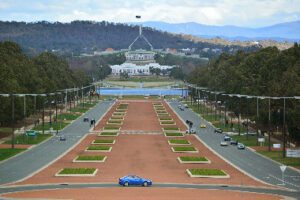As tax time approaches, it’s essential for investors—whether in shares, property, managed funds, or crypto—to…
2024-25 Federal Budget – Some Early Highlights
 STAGE 3 TAX CUTS
STAGE 3 TAX CUTS
The Government’s changes to the Stage 3 tax cuts are a key element of the Budget.
These changes are intended to broaden the benefit of the original tax cuts, significantly reducing the tax break for wealthier taxpayers and increasing the benefit for those on lower incomes. The original stage three tax cuts sought to ‘flatten’ the tax system by abolishing a tax bracket and address bracket creep by pushing out the top tax bracket. The revised changes retain the tax bracket that would have been abolished but adjust tax rates to benefit both lower and higher-income earners. The changes take effect from July 1, with the Tax Office simply taking less tax from pay packets.
The Grattan Institute’s analysis showed that low and middle-income earners win, high-income earners lose. The changes cut the bottom tax rate which applies to incomes below $45,000, from 19 per cent to 16 per cent. That will give a tax cut of up to $804 a year to all tax-filers, including those on higher incomes. At the same time Stage 3 tax cuts for higher earners are reduced. Under the original plan a single 30 per cent rate was to apply to incomes between $45,000 and $200,000. Instead, this rate will apply to incomes between $45,000 and $135,000. The existing 37 per cent rate, which was to be abolished, is now retained, and applies to incomes between $135,000 and $190,000. And the top rate of 45 per cent will remain for incomes above $190,000, rather than the $200,000 level originally envisaged.
| Stage 3 – revised tax brackets | |
| 0 – $19,000 | Nil |
| $19,001 – $45,000 | 16 cents for each $1 over $19,000 |
| $45,001 – $135,000 | $4,160 plus 30.0 cents for each $1 over $45,000 |
| $135,000 – $190,000 | $31,160 plus 37 cents for each $1 over $135,000 |
| $190,001 and over | $51,510 plus 45 cents for each $1 over $200,000 |
COST OF LIVING
The Budget’s key new cost-of-living measure is a new energy bill relief payment, extending existing energy relief measures.
From 1 July 2024, the Budget provides rebates of $300 to every household and $325 to around one million small businesses.
There is also relief for renters by increasing maximum rates of Commonwealth Rent Assistance by an additional 10 per cent. This increase will support nearly one million households.
The Budget also continues the freeze on social security deeming rates at their current levels for a further 12 months until 30 June 2025.
CARER PAYMENT
Recipients of the Carer Payment may have greater flexibility to undertake part-time work without impacting their entitlements.
From 20 March 2025, the existing 25 hour per week participation limit for Carer Payment recipients will be amended to 100 hours over a four-week period. The participation limit will no longer capture study, volunteering activities and travel time and will only apply to employment.
If the participation limit (or the allowable temporary cessation of care days) is exceeded, payments will be suspended for up to six months rather than cancelled.
AGED CARE
Aged care measures announced in this year’s Budget continue to focus on increasing access to home care, improving the quality and regulation of aged care services and addressing workforce issues. The aged care proposals come at a cost of $2.2 billion.
Included in the 2024-25 Budget were implications for:
- More home care packages
- Increased funding to the Aged Care Quality & Safety Commissioner • Investment into IT systems and service delivery for Services Australia and MyAgedCare
- Pay increases for aged care workers
- A new Aged Care Act deferred until 1 July 2025
- Flexibility for recipients of the Carer Payments (see earlier comments).
The government is sitting on a series of contentious recommendations around aged care. The responsible minister, Anika Wells, has argued there’s strong case to increase the co-contributions of wealthy retirees towards their care.
SUPERANNUATION
The Budget includes $1.1 billion to pay superannuation on Government-funded Parental Leave.
The 2023-24 Budget maintained the Super Guarantee’s legislated increase to 12 per cent. From 1 July 2024, the Super Guarantee will increase to 11.5 per cent. It will continue to increase by 0.5 per cent on 1 July each year until it reaches 12 per cent in 2025.
The 2023-24 Budget also required superannuation to be paid with salary and wages to tackle unpaid super. From 1 July 2026, employers will be required to pay their employees’ super at the same time as their salary and wages.
EDUCATION
Higher Education Contributions
Ahead of the Budget the Government announced changes to higher education funding affecting student debts of more than three million people, wiping more than $3 billion from their accumulated debt.
The Government will reduce the indexation of accumulated student contribution debt and will backdate the new system to 2023. The Government estimates about $3 billion in indexation debt will be cancelled, helping about 3 million Australians.
The change will cap the HELP indexation rate to be the lower of either the Consumer Price Index (CPI) or the Wages Price Index (WPI), backdated to June 1 last year. At present the indexation is based on the CPI. The new indexation arrangement will be backdated to all HELP, VET Student Loan, Australian Apprenticeship Support and other student support loan accounts.
The change requires legislation.
Student ‘Prac Payments’
Ahead of the Budget the Government announced a new ‘Commonwealth Prac Payment’ which will provide a student payment of $319.50 a week for higher education student while on clinical and professional placements.
The payment will be means tested and start from July 1 2025, which will be after the next election.
Those eligible will include people studying:
- teaching
- nursing
- midwifery
- social work
The payment is benchmarked to the single Austudy rate. It will be in addition to other income support a student might receive.
FUTURE MADE IN AUSTRALIA
The Budget provides some more detail – though many will believe it remains vague – of the Government’s ‘Future Made in Australia’ plan.
The subsidy for the National Interest Account will cost the Budget $911 million in 2024-25, the Budget Papers say, and $2.658 billion over the forward estimates.
Under the ‘Future Made in Australia the Government will also:
- establish a new front door for investors with “major, transformational investment proposals to make it simpler to invest in Australia and attract more global and domestic capital”.
- Provide $15.7 million to deliver a stronger, more streamlined and more transparent approach to foreign investment.
- Commit $27.7 million to help Australians benefit from cheaper, cleaner energy sooner by supporting development of priority reforms to ensure consumer energy resources, such as rooftop solar, household batteries and electric vehicles.
- Accelerate the growth of new industries by providing a $1.5 billion extension over seven years to the Australian Renewable Energy Agency’s industry-building investments and establishing the $1.7 billion Future Made in Australia Innovation Fund.
The Future Made in Australia plan will include previously announced subsidy schemes, including the $1 billion “Solar Sunshot” program, unveiled by the prime minister last month to “help ensure more solar panels are made in Australia”. The Federal Government will also provide $470 million for PsiQuantum, a quantum computer startup in Brisbane, with matching funds from the Queensland Government and $1.5 billion from the National Reconstruction Fund to increase Australia’s medical manufacturing capabilities. Longer term, the government is also investing $12.6 billion in research and development programs at institutions such as the CSIRO, under the plan.
HOUSING
In addition to the previously mentioned increase in rental assistance, the Budget includes another $1 billion to help states and territories build more housing sooner, an additional $1.9 billion in loans to help build 40,000 social and affordable homes, and $1 billion towards accommodation for women and children fleeing domestic violence.
Ahead of the Budget a special National Cabinet meeting agreed on $12.3 billion in new housing programs intended to ease fears of housing shortages. The package included new support for women and children who need shelter after fleeing domestic violence.
Prime Minister Anthony Albanese struck a deal with state and territory leaders last Friday to inject more cash into construction, including a five-year agreement on social housing that will repair homes and expand crisis support.
A key element of the deal is a $1 billion payment to the states and territories to build roads and other infrastructure needed to support new housing developments, answering calls for more facilities for homes in the suburbs.
The $12.3 billion will be spent over five years and includes $1 billion for emergency accommodation for women and children, the $1 billion to the states and territories for roads and other facilities, and anew $9.3 billion national agreement on social housing.
VIOLENCE AGAINST WOMEN
Ahead of the Budget and following a special National Cabinet meeting to consider measures to counter violence against women, Prime Minister Anthony Albanese announced the federal government would invest $925 million over five years to permanently establish the Leaving Violence Program, which gives women $5000 in financial support.
However, the $925 million does not start until the middle of next year. This program replaces and rebrands a trial policy set up under former prime minister Scott Morrison in October 2021 and called the Escaping Violence Payment. As with the trial, the new scheme offers $1500 in
NDIS
The Budget includes providing $469 million to keep working with the disability community and the states and territories, and to crack down on fraud and exploitation of the NDIS.
The Budget forecasts that payments related to the NDIS will increase by $1.3 billion in 2023–24 and $15.9 billion over five years from 2023–24 to 2027–28.
Ahead of the Budget spending on the NDIS had been predicted in early 2022 to hit $42.9 billion. Ahead of this year’s Budget, that forecast had been pushed up to $47.3 billion, an increase of more than 10 per cent.
Source: www.fiducian.com.au
Lindale Insurances Pty Ltd ATF Lindale Insurances Trust ABN 27 027 421 832 is a Franchisee of Fiducian Financial Services Pty Ltd, Level 4, 1 York Street, Sydney NSW 2000. AFSL 231103 ABN 46 094 765 134.
The information (including taxation) provided on this website is general in nature and does not consider your individual circumstances or needs. Do not act until you seek professional advice and consider a Product Disclosure Statement.
Disclaimer: The views expressed in this publication are solely those of the author; they are not reflective or indicative of Fiducian. They cannot be reproduced in any form without the express written consent of the author.



